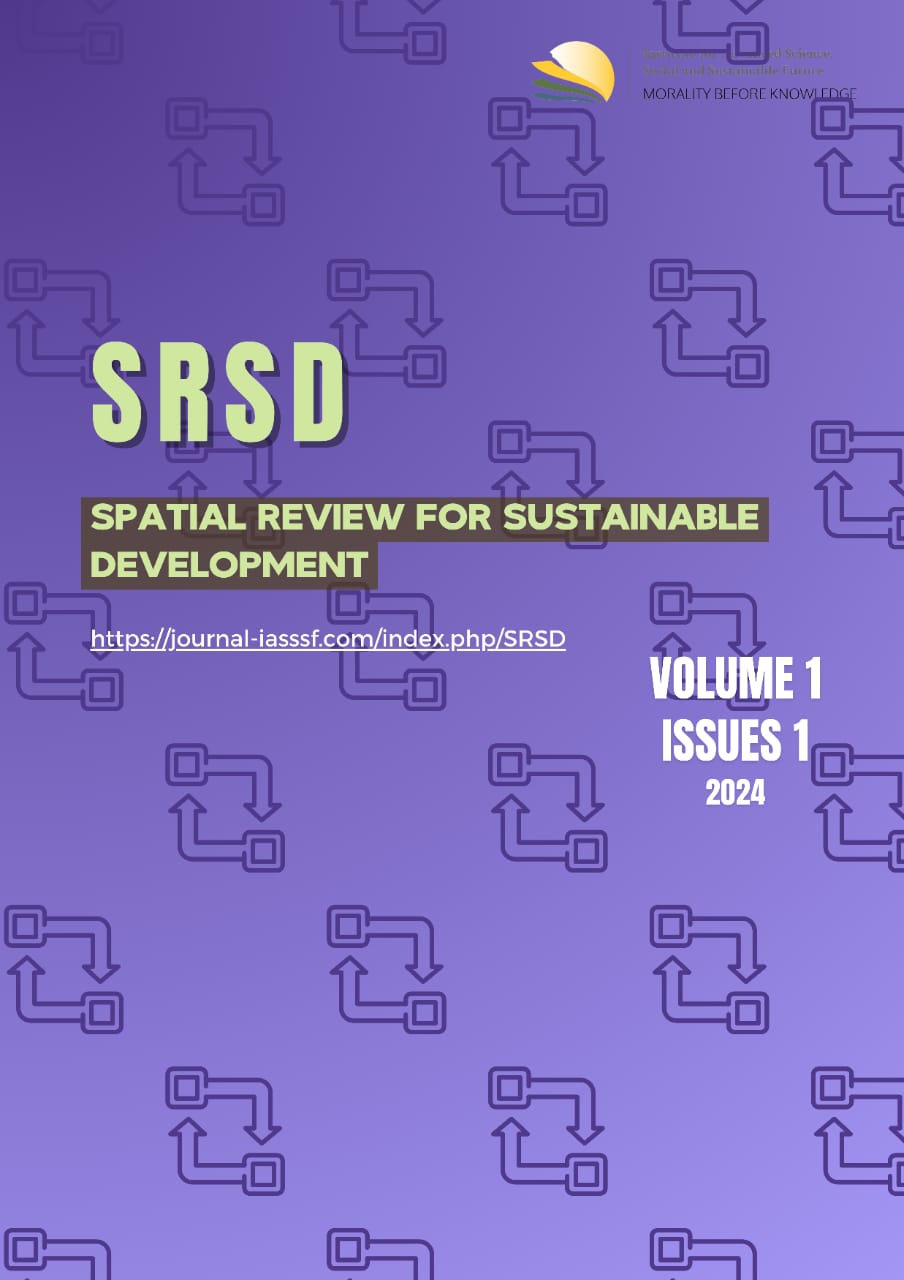Identification of urban green space availability and utilization in Semarang City
DOI:
https://doi.org/10.61511/srsd.v1i1.2024.410Keywords:
urban green space availability, urban green space mapping, urban green space utilization.Abstract
Background: Urban green space land a has been used differently because of Semarang City's rapid development in several sectors, including industry, transportation, and economics. Gajahmungkur Subdistrict determined that the minimum urban green space requirement of 30% had been reached. Methods: The method used in this research is quantitative method with remote sensing. Quantitative methods are used as systematic, rational, measurable, objective, and concrete methods. Findings: However, the identification results may not represent the total amount of urban green space in the village. Conclusion: Therefore, using remote sensing satellite image interpretation of Sampangan Village, the results of urban green space identification amounted to 22.97 ha or 22.6% of the 77.4% non-urban green space area with most of the land being urban green space of riparian type connected to Sampangan Park as a form of utilizing riparian urban green space which is frequently used by visitors to traders. In addition, Kelurahan Sampangan has urban green space utilization in the form of river borders, Sampangan Park, Sampangan Mitra Field, UNNES Labschool Elementary School sports field, Wotgaleh Cemetery, and parking lots. Sampangan Village only has 22.6% of the required minimum of 30% of urban green space, so it still falls short of the standard. Thus, efforts are needed to increase the provision of urban green space in Sampangan Village to become a residential area that is suitable for people to live in from an environmental aspect.
References
Batubara, C.M., & Dewi, D.I.K. (2018). Persepsi Pengguna Terhadap Keberadaan Taman Sampangan Sebagai Kebutuhan Rekreasi. Ruang, 4(2), 155-163. https://doi.org/10.14710/ruang.4.2.155-163
Haq, S. M. A. (2015). Urban green spaces and an integrative approach to sustainable environment. Urban Ecology: Strategies for Green Infrastructure and Land Use, 147. https://www.researchgate.net/publication/276488760_Urban_Green_Spaces_and_an_Integrative_Approach_to_Sustainable_Environment
Fariz, T. R., Jatmiko, R. H., Mei, E. T. W., & Lutfiananda, F. (2023). Interpretation on aerial photography for house identification on landslide area at Bompon sub-watershed. In AIP Conference Proceedings (Vol. 2683, No. 1). AIP Publishing. https://doi.org/10.1063/5.0125382
Haaland, C., & van Den Bosch, C. K. (2015). Challenges and strategies for urban green-space planning in cities undergoing densification: A review. Urban forestry & urban greening, 14(4), 760-771. https://doi.org/10.1016/j.ufug.2015.07.009
Hanson, H. I., Eckberg, E., Widenberg, M., & Olsson, J. A. (2021). Gardens’ contribution to people and urban green space. Urban For. Urban Green 63, 127198. https://doi.org/10.1016/j.ufug.2021.127198
Indraputra, A., & Hidayati, I.N. (2016). Pemanfaatan Citra Penginderaan Jauh untuk Pemetaan Ketersediaan Ruang Terbuka Hijau dan Tingkat Kenyamanan di Sebagian Kota Semarang. Jurnal Bumi Indonesia, 5(1). https://media.neliti.com/media/publications/79335-ID-pemanfaatan-citra-penginderaan-jauh-untu.pdf
Ismayanti, T., Sasmito, B., & Bashit, N. (2019). Evaluasi Ruang Hijau Terbuka Terhadap Tingkat Kenyamanan Termal (Studi Kasus: Kota Semarang, Jawa Tengah). Jurnal Geodesi Undip, 9(1), 136-145. https://doi.org/10.14710/jgundip.2020.26112
Kelly-Fair, M., Gopal, S., Koch, M., Pancasakti Kusumaningrum, H., Helmi, M., Khairunnisa, D., & Kaufman, L. (2022). Analysis of land use and land cover changes through the lens of SDGs in Semarang, Indonesia. Sustainability, 14(13), 7592. https://doi.org/10.3390/su14137592
Lahoti, S., Kefi, M., Lahoti, A., & Saito, O. (2019). Mapping methodology of public urban green spaces using GIS: An example of Nagpur City, India. Sustainability, 11(7), 2166. https://doi.org/10.3390/su11072166
Le, Y., & Huang, S. Y. (2023). Prediction of Urban Trees Planting Base on Guided Cellular Automata to Enhance the Connection of Green Infrastructure. Land, 12(8), 1479. https://doi.org/10.3390/land12081479
Nugraha, A. L., Awaluddin, M., Sukmono, A., Bashit, N., Wahyuddin, Y., & Nugraha, P. O. (2023). Environmental vulnerability assessment based on open green space mapping with AHP and GIS in East Semarang sub-district. In AIP Conference Proceedings (Vol. 2722, No. 1). AIP Publishing. https://doi.org/10.23887/mkg.v24i1.58712
Prakoso, P., & Herdiansyah, H. (2019). Analisis implementasi 30% ruang terbuka hijau di DKI Jakarta. Majalah Ilmiah Globe, 21(1), 17-26. https://doi.org/10.24895/MIG.2019.21-1.869
Pratiwi, I., Wicaksono, D., Wibowo, A. A., & Setiyawan, A. (2022). The relationship of traders’ activities to the quality of city park (case study: Taman Sampangan Semarang). In IOP Conference Series: Earth and Environmental Science (Vol. 969, No. 1, p. 012066). IOP Publishing. https://doi.org/10.7340/anuac2239-625X-3075
PUPR (Indonesia Ministry of Public Works and Housing). 2008. Peraturan Menteri Pekerjaan Umum dan Perumahan Rakyat tentang Pedoman Penyediaan Dan Pemanfaatan Ruang Terbuka Hijau Di Kawasan Perkotaan. Indonesia. https://jdih.pu.go.id/detail-dokumen/1236/1#div_cari_detail
Purnomohadi, N. (2006). Ruang Terbuka Hijau Sebagai Unsur Utama Tata Ruang Kota. Jakarta: Direktorat Jenderal Penataan Ruang, Kementerian PU. https://www.nawasis.org/portal/digilib/read/ruang-terbuka-hijau-sebagai-unsur-utama-tata-ruang-kota/2840
Retnaningsih, S. (2017). Kajian Evaluatif Ruang Terbuka Hijau (RTH) Taman Sampangan dan Taman Tirtoagung di Kota Semarang (Disertasi Doktor, Pasca Sarjana Unika Soegijapranata). http://repository.unika.ac.id/15042/
Santoso, E. B., Rahmadanita, A., & Ryandana, M. D. (2022). Ruang Terbuka Hijau di Kota Samarinda: Pencapaian, Permasalahan, dan Upayanya. Jurnal Ilmu Pemerintahan Widya Praja, 48(1), 103-126. https://doi.org/10.33701/jipwp.v48i1.2828
Sari, P., & Diah, S. (2019) Peran kampung tematik dalam peningkatan pendapatan keluarga : studi kasus Kampung Tani dan Kampung Kamsoli. Undergraduate (S1) thesis, UIN Walisongo. https://eprints.walisongo.ac.id/id/eprint/11091/
Sasmito, B., Prasetyo, Y., Bashit, N., & Ismayanti, T. (2019). Spatial Model of Green Open Space Needs for Mitigation of Urban Heat Island Phenomenon in Semarang. KnE Engineering, 20-33. https://doi.org/10.18502/keg.v4i3.5818
Setyowati, D. L., Wilaksono, S. A., Aji, A., & Amin, M. (2021). Assessment of watershed carrying capacity and land use change on flood vulnerability areas in Semarang City. In Forum Geografi (Vol. 35, No. 2). https://doi.org/10.23917/forgeo.v35i2.15542
Sudarwani, M.M., & Ekaputra, Y.D. (2017). Kajian penambahan ruang terbuka hijau di kota Semarang. Jurnal Teknik Sipil Dan Perencanaan, 19(1), 47-56. https://doi.org/10.15294/jtsp.v19i1.10493
Sugiyono. 2008. Statistika untuk penelitian, Alfabeta, Bandung. https://staffnew.uny.ac.id/upload/131808329/penelitian/17B_Editor+Buku+Statistik.pdf
Zahra, D. F., & Fariz, T. R. (2023). Tingkat Kesadaran Masyarakat Dalam Memanfaatkan Dan Mengendalikan Ruang Terbuka Hijau Privat di Kecamatan Semarang Timur. Journal of Enviromental Science Sustainable, 4(1), 26-33. https://doi.org/10.31331/envoist.v4i1.2295
Zahra, D. F., Juhadi, J., Aji, A., & Fariz, T. R. (2020). Tingkat Pengetahuan Masyarakat Terhadap Pemanfaatan Dan Pengendalian Ruang Terbuka Hijau Privat Di Permukiman Kecamatan Semarang Timur. In Prosiding Seminar Nasional Geografi III-Program Studi Pascasarjana Geografi. https://www.academia.edu/89028926/Tingkat_Pengetahuan_Masyarakat_Terhadap_Pemanfaatan_Dan_Pengendalian_Ruang_Terbuka_Hijau_Privat_Di_Permukiman_Kecamatan_Semarang_Timur
Downloads
Published
Issue
Section
Citation Check
License
Copyright (c) 2024 Spatial Review for Sustainable Development

This work is licensed under a Creative Commons Attribution 4.0 International License.














